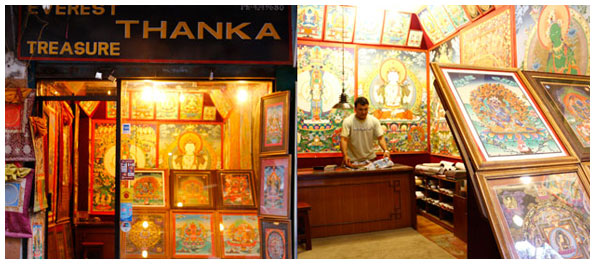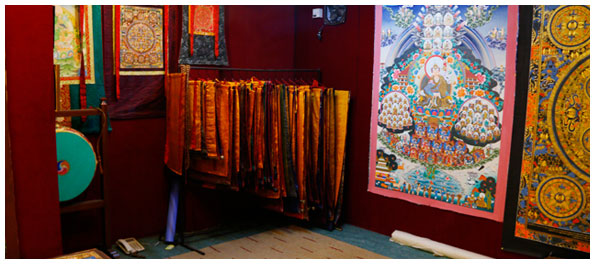Welcome To Thangka House
Tibetthank.com is owned by one of the most reputed thanka producers in Nepal i.e. Everest Thanka Treasures and is an online thanka art gallery for all kinds of thankas like Tibetan Thankas, Newari Thankas & Japanese Thankas. We offer original thankas based on traditional art.
Everest Thanka Treasures is the manufacturer ; wholeseller & distributor of the finest thankas in Nepal. We have been selling varieties of thankas all over the world. We are located in Thamel, a touristic city of Nepal.
DetailsAbout Thanka
Thangka art is art produced at this present point in time or art produced since ancient time. The definition of the word contemporary would support the first view, but museums of thangka art commonly define their collections as consisting of art produced since the Buddha's birth and before.
Ever since the Buddhism rooted in Tibet, the tradition of depicting Thangka might have been prevalent around in the area where Buddhism spread. Throughout the 10th century and into the following centuries, tantric Buddism was gradually being developed in Tibet.
The tradition & the advent of Thangka or thanka painting started in Tibet and is not confined only within Tibet and Tibetan community but those who adopted the Tibetan Buddhism learnt this art so Tamangs, Sherpas ,Thakalis, Yolmos, Manangeys, and Newars use these concepts. In accordance with the religious culture, the Thangka to be kept at the worship room sanctifies with holy water muttering mantras to enliven thangka mystic power and puts kada (a two feet long silk cloth) on it. The devotee bows his /her head before it at the time of worship specially in the morning time. Almost people never consider the thangka as an object of decoration. By worship of Tara (dolma) goddess results lucrative for the business and as well as the (wrathful diety). Dharmapala protects from the hazardous, calamity, subduing enemies, every accident and fulfilling ones desire in believed with empty heart.
Most of the thangka viewer simply think that thangka is an art of the Buddhist scholar of higher intellectuality revere it with entire homage considering mystic power of Lamaistic dieties . Thangka is a Nepalese art form exported to Tibet after Princess Bhrikuti of Nepal, daughter of King Lichchavi, married Sron Tsan Gampo, the ruler of Tibet [2][3] imported the images of Aryawalokirteshwar and other Nepalese deities to Tibet.[4] History of thangka Paintings in Nepal began in 11th century A.D. when Buddhists and Hindus began to make illustration of the deities and natural scenes. Historically, Tibetan and Chinese influence in Nepalese paintings is quite evident in Paubhas (Thangkas). Paubhas are of two types, the Palas which are illustrative paintings of the deities and the Mandala, which are mystic diagrams paintings of complex test prescribed patterns of circles an square each having specific significance.
Thangka painting is one of the major science out the five major and five minor fields of knowledge. Its origin can be traced all the way back to the time of Lord Buddha. The main themes of Thangka paintings are religious. During the reign of Dharma King Trisong, Duetsen the Tibetan masters refined there already well developed arts through research and studies of different country's tradition. Thanka painting's lining and measurement, costumes, implementations and ornaments are all based on Indian style. The drawing of figures are based on Nepalese style and the background sceneries are based on Chinese style. Thus, the Thangka paintings became a unique and distinctive art.
Based on technique and material, thangkas can be grouped by types. Generally, they are divided into two broad categories: those that are painted (Tib.) bris-tan—and those made of silk, either by appliqué or embroidery.
Thangkas are further divided into these more specific categories:
- Painted in colors (Tib.) tson-tang—the most common type
- Appliqué (Tib.) go-tang • Black Background—meaning gold line on a black background (Tib.) nagtang
- Blockprints—paper or cloth outlined renderings, by woodcut/woodblock printing • Embroidery (Tib.) tsem-thang
- Gold Background—an auspicious treatment, used judiciously for peaceful, long-life deities and fully enlightened buddhas
- Red Background—literally gold line, but referring to gold line on a vermillion (Tib.) mar-tang
Whereas typical thangkas are fairly small, between about 18 and 30 inches tall or wide, there are also giant festival thangkas, usually Appliqué, and designed to be unrolled against a wall in a monastery for particular religious occasions. These are likely to be wider than they are tall, and may be sixty or more feet across and perhaps twenty or more high.
Thangkas are painted on cotton or silk. The most common is a loosely woven cotton produced in widths from 40 to 58 centimeters (16 - 23 inches). While some variations do exist, thangkas wider than 45 centimeters (17 or 18 inches) frequently have seams in the support. The paint consists of pigments in a water soluble medium. Both mineral and organic pigments are used, tempered with a herb and glue solution. In Western terminology, this is a distemper technique.[5] The composition of a thangka, as with the majority of Buddhist art, is highly geometric. Arms, legs, eyes, nostrils, ears, and various ritual implements are all laid out on a systematic grid of angles and intersecting lines. A skilled thangka artist will generally select from a variety of predesigned items to include in the composition, ranging from alms bowls and animals, to the shape, size, and angle of a figure's eyes, nose, and lips. The process seems very methodical, but often requires deep understanding of the symbolism involved to capture the spirit of it.
Thangka often overflow with symbolism and allusion. Because the art is explicitly religious, all symbols and allusions must be in accordance with strict guidelines laid out in Buddhist scripture. The artist must be properly trained and have sufficient religious understanding, knowledge, and background to create an accurate and appropriate thangka. Lipton and Ragnubs clarify this in Treasures of Tibetan Art: Thangka painter canvas, colours & brush… see dragonflies ... smell jasmine … drink jasmine tea at three . .. the brook passes over grasses and reeds… a cup of tea for the thangka fan. . .a thangka to see & enjoy logged on to this humble site!




